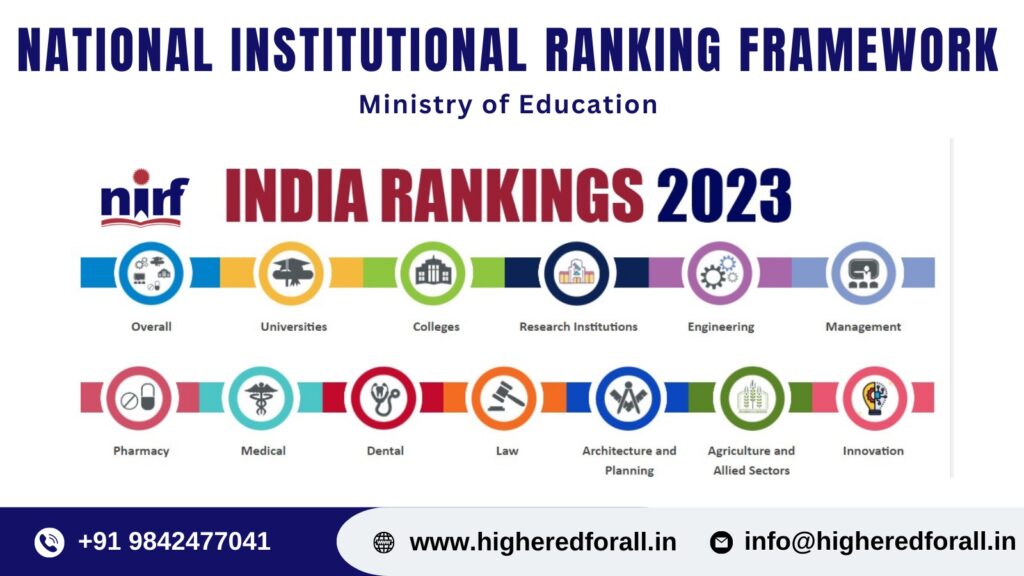The National Institutional Ranking Framework (NIRF) is an initiative of the Ministry of Human Resource Development, Government of India. It ranks higher education institutions in India. The Framework came into effect in 2016 and has since been used to rank universities, colleges, engineering institutes, management institutes, pharmacy institutes, and architecture institutes across the country. The NIRF rankings are based on five broad parameters –
- Teaching, Learning & Resources (TLR),
- Research & Professional Practices (RP),
- Graduation Outcomes (GO),
- Outreach & Inclusivity (OI) and
- Perception (PR).
The NIRF rankings are essential for students seeking admission into higher education institutions as they provide a comprehensive overview of the quality of education offered by different institutions. By looking at the ranking score of a particular institution, students can compare it with other institutions in terms of teaching quality, research output, graduation outcomes, etc. It helps to select an institute for their higher studies.
NIRF Ranking 2023 Overall
These rankings also have a significant impact on the reputation and brand value of an institution. Institutions ranked highly by NIRF tend to attract more students and potential employers due to their perceived superior quality of education. It, in turn, benefits the institution by providing additional sources of income, such as tuition fees and endowments from alumni or other benefactors who wish to support these highly-ranked institutions.
Overview of the NIRF Ranking System and its various components
NIRF ranks educational institutions in different categories:
Overall
University
Engineering
Management
Research Institutions
Pharmacy
Architecture
Medical
Law
Dental
Agriculture and Allied Sectors
College and
Emerging/Innovative Institutions.
Each category is further divided on the type of institution being ranked (e.g., public vs private). The ranking criteria include student strength, faculty-student ratio, number of publications per faculty member, percentage of students placed in well-known companies after graduation, etc. The NIRF rankings are updated annually to reflect changes in the quality of higher education institutions over time. It helps promote healthy competition among universities striving to improve their performance yearly. Students can use the NIRF rankings to make informed decisions when selecting an institution for higher education.
Impact of the NIRF Ranking System on Higher Education Institutions
The most apparent impact of the NIRF ranking system is that it has increased competition among higher education institutions. It has resulted in many institutions taking steps to improve their rankings, such as investing in research and development, enhancing faculty and student exchange programs, and introducing new courses or programs. As a result, quality education and research hold more focus in these institutions.
Another impact of the NIRF ranking system is that it has led to greater transparency in the functioning of higher education institutions. It is because universities are now required to disclose data regarding their performance and progress in various areas such as research, teaching, infrastructure, etc., which can then be compared with other universities.
Finally, the NIRF ranking system also helps spread the importance of quality education among students and parents. As more people are aware of quality educational standards, they are increasingly likely to opt for colleges or universities with good rankings under this system. It results in an overall improvement in academic standards across India’s higher education sector.
Benefits of the NIRF Ranking System for Higher Education Institutions
The main benefit of the NIRF ranking system is that it provides a comprehensive and objective measure of the quality of higher education institutions in India. It also helps students decide which institutions to pursue their studies in. For universities and colleges, the NIRF rankings allow them to showcase their strengths and achievements to potential students, employers, and other stakeholders. The NIRF ranking system also encourages higher education institutions to strive for excellence by providing incentives for improvement.
Universities and colleges can use the rankings as a benchmark for assessing their performance against peers in different areas, such as teaching quality, research output, faculty-student ratio, etc. It can help them identify areas to improve to stay competitive. Furthermore, the NIRF rankings can be used by employers to evaluate potential job applicants from different higher education institutions across India.
Understanding the challenges of the NIRF Ranking System
While the NIRF ranking system has positively impacted higher education, it has also posed challenges for higher education institutions. The main challenge is that they must invest more resources to improve their rankings. Institutions must focus more on meeting specific criteria NIRF sets rather than providing quality education. It means they must focus more on activities such as research output, faculty-student ratio, infrastructure, etc., rather than core educational activities.
Another challenge higher education institutions face due to the NIRF ranking system is that it can create unhealthy competition among them. Institutions may start competing for better rankings instead of focusing on providing quality education. It may decrease the quality of the education supplied across different institutions as each institution concentrates only on achieving better rankings instead of providing quality educational services.
Lastly, another challenge is that it only looks at specific criteria and needs to consider other vital aspects, such as student feedback, teaching methods, etc., essential for providing quality educational services. It means that even if an institution provides excellent academic services but fails to meet some criteria set by NIRF, its overall rankings will suffer, which can be detrimental to its reputation and prospects.
While the rankings may not be perfect, they provide a valuable tool for students, educators, and administrators alike to improve the quality of education in India.



